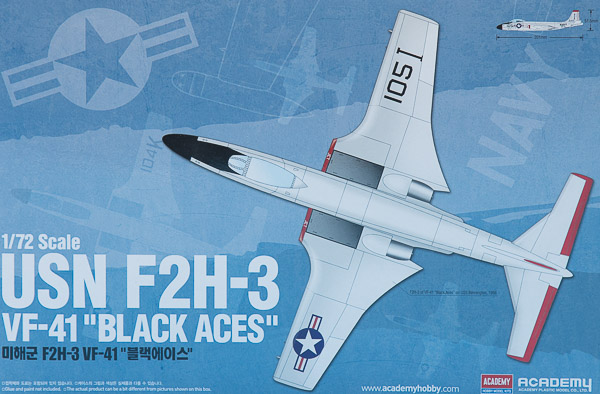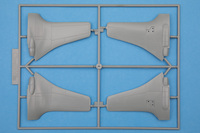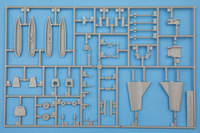
Academy 1/72 USN F2H-3 Banshee VF-41 "Black Aces"
By Chris Banyai-Riepl
Overview
The McDonnell Banshee was developed from the FH Phantom, with the goal of improving on that design before it even entered service. The F2H ended up being a completely new design, and the F2H-2 operated during the Korean War in both the US Navy and the US Marine Corps. The F2H-3 featured a longer fuselage, relocated horizontal stabilizers, a radar system, and an increase in cannon ammunition capacity. The final variant, the F2H-4, was externally identical to the F2H-3, with just an engine change and an updated radar making up the variant difference. The Banshee remained in service for most of the 1950s until replaced by more capable aircraft such as the F9F-8 Cougar and F11F Tiger.
The Kit
Academy's kit of the F2H-3/4 Banshee has been out for quite a while, originally appearing under the Hobbycraft label. The kit is molded in a light gray plastic with recessed panel lines and simple detailing. Options include underwing rockets and separate wingtip tanks. The decal sheet in this kit provides markings for seven variants, with USN, USMC, and Royal Canadian Navy subjects all covered.

|

|
Construction is very straightforward on this kit, and building it straight out of the box should not take long. For those who want to add more detailing, there's plenty of opportunity to do that as well. One of those areas is the cockpit. The kit comes with a simple tub, a separate instrument panel and control stick, and a rear bulkhead. The one-piece seat completes the interior. All of this could be improved with the addition of either resin or photoetch, or both.
Once the interior is done, the rest of the assembly will go very quickly. With some added weight in the nose and the cockpit interior in place, the fuselage can go together. For the wings, these are split into upper and lower halves and get the intake and exhaust bits added in between. Separate intake splitter plates on the fuselage finish up this assembly. The stabilizers are separate and single pieces, which just leaves the landing gear as the last major structure to add. These are made up of a one-piece nose gear that includes the wheel, and main gear that has separate wheels and a two-piece strut. Add the doors and you can turn to the external stores.

|

|
For under the wing, there are four hardpoints included, which would typically carry either rockets or bombs. Rockets are included in the kit, and while those are decent, these too would benefit from replacement with high quality resin versions. Really, though, the lines of the Banshee really call out for keeping it clean under the wing. The tip tanks are another option, and only the third decal choice shows them in place. Still, the kit includes them should you wish to add those to your model. If you go with a clean look, though, you'll have to trim off the mounting tab.
 The decals are nicely printed overall and feature colorful markings and extra details and stenciling to make for a realistic finished model. The first option is a gull gray and white F2H-3 from VF-41 "Black Aces" off the USS Bennington in 1956. The second option is an overall silver F2H-3 from VF-31 "Tophatters" off the USS Ticonderoga in 1956. The third option is a gull gray and white F2H-4 of VMF-214 "Black Sheep" in 1957. The fourth option is a gull gray and white F2H-4 of VF-52 "Knightriders" off the USS Ticonderoga in 1958. The remaining options are Canadian and are all camouflaged in dark gray over light gray, with the fifth from VF-870 at RCNAS Shearwater in 1956, the sixth from VF-870 off the HMCS Bonaventure in 1958, and the seventh from VF-871, also off the HMCS Bonaventure in 1958.
The decals are nicely printed overall and feature colorful markings and extra details and stenciling to make for a realistic finished model. The first option is a gull gray and white F2H-3 from VF-41 "Black Aces" off the USS Bennington in 1956. The second option is an overall silver F2H-3 from VF-31 "Tophatters" off the USS Ticonderoga in 1956. The third option is a gull gray and white F2H-4 of VMF-214 "Black Sheep" in 1957. The fourth option is a gull gray and white F2H-4 of VF-52 "Knightriders" off the USS Ticonderoga in 1958. The remaining options are Canadian and are all camouflaged in dark gray over light gray, with the fifth from VF-870 at RCNAS Shearwater in 1956, the sixth from VF-870 off the HMCS Bonaventure in 1958, and the seventh from VF-871, also off the HMCS Bonaventure in 1958.
Conclusion
For those wanting to add a late-mark Banshee to their shelves, this is just about your only option in 1/72. Luckily it is a solid kit that builds up easily and has plenty of aftermarket options to make the detail hound happy. My thanks to MRC for the review copy.
